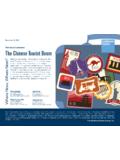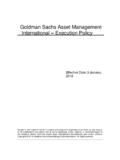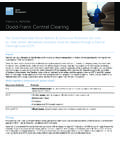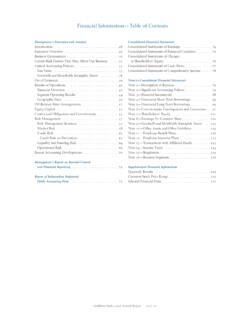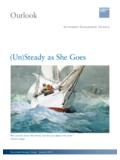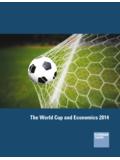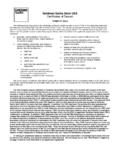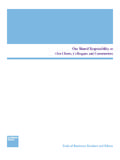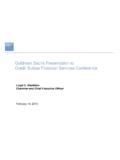Transcription of Revisiting the Role of Insurance Company ALM within a Risk ...
1 Revisiting the Role of Insurance Company ALMwithin a Risk Management FrameworkWhite PaperOctober 2010 Insurance Asset ManagementExecutive SummaryAs Insurance sector fundamentals have improved over the past two years, we take afresh look at the role of Insurance Company Asset Liability Management (ALM) andinvestment strategy. We look back at the impact of the financial crisis on US insurers,and how the industry responded. We observe signs of progress on financial statementsthat began to take hold starting in 2009, including improved capital adequacy, netincome and lower realized losses as compared to 2008. However, when we look moreclosely at the post-crisis rebound, we note these improvements have largely beendriven by regulatory changes, capital raising and reductions in dividends paid. Inaddition, the current prolonged low interest rate environment is expected to producelower investment earnings potential, albeit partially offset by redeployment of elevatedcash balances and improved performance on alternative investments.
2 Now more thanever, we propose a revised ALM, risk management and investment strategy frameworkas a catalyst to improve the decision-making process and, ultimately, the operatingperformance of the Insurance GSAM s Insurance Strategy team, we are focused on advising insurers globallyon the role of ALM, recognizing the need for this integrated ALM framework. In thiswhite paper, we explore the complexities and stress within the US life Insurance industryduring the financial crisis and then present a case study applicable to all insurers todemonstrate ALM at work. We illustrate an overall ALM framework that is holistic,incorporates effective diversification of market risk and return sources, and focuses oncapital preservation. We believe this framework can help insurers be more nimble andproactive in a variety of market environments. It is critical to build ALM andinvestment strategy processes that are linked together and part of an overall riskframework, with clearly defined risk budgets and risk reporting.
3 This approach willempower an Insurance Company CEO to more efficiently manage through anothervolatile capital market :Executive summary.. 1 Complex landscape for insurers.. 2 History of the financial crisis from US life insurers perspective .. 3 GSAM s approach to ERM.. 7 GSAM s ALM and SAA process .. 8 Case study: ALM at work .. 11 Conclusion .. 19 This material is provided for educational purposes only and should not be construed as investment advice or an offer orsolicitation to buy or sell | Goldman Sachs Asset ManagementRevisiting the Role of Insurance Company ALM within a Risk Management FrameworkComplex Landscape for InsurersInsurers have a variety of key stakeholders focused on, in some cases, vastly different metrics. Theymust answer to policyholders, shareholders, rating agencies, regulators and tax agencies, to name afew. Each stakeholder within a life insurer s universe serves a unique purpose, with its own objectivesand constraints that sometimes complement and at other times conflict with each other.
4 In addition, an insurer with multiple legal entities and lines of business has to manage to itsgroup s overall balance sheet and regulatory framework but also may need to focus on managingand reporting financials and capital adequacy at the legal entity level. For insurers that are publiclytraded, they also report financials based on the accounting requirements of their group s , each rating agency has a different set of criteria to evaluate the capital adequacy andfinancial strength of the insurer. Further complicating the job of risk management and ALM forlife insurers, many of the stakeholders use different metrics to measure assets, liabilities and the financial crisis, we believe the challenges for insurers were more complicated becauseof the multi-layered world in which they operate. In the table below, we illustrate some of thehigh level differences among these metrics and how they were impacted by the US Insurers Evaluate Their BusinessesSource: GSAM.
5 For illustrative purposes only. Certainly, insurers pay attention to all of the stakeholders and their metrics. But before the crisis,insurers focused more on accounting and rating agency measures that serve the interest of theinvestor community, including return on equity (ROE) and rating agency criteria. These are notnecessarily mutually exclusive, but, as the crisis unfolded and the investor community began torecognize the potential need for US life insurers to raise capital, the attention quickly turned tothe statutory balance sheet. There was a quick and sudden shift in focus to determine capitaladequacy based on the statutory balance sheet and National Association of InsuranceCommissioners (NAIC) risk-based capital. MetricPrimary ObjectiveKey CharacteristicsCrisis Impact Accounting(GAAP, IFRS)Allocate income and expenses to the period earned; focus on shareholderA mix of principles-based andeconomic valuation Unrealized losses grew to an uncomfortable level that led to a focus on the economicframework Economic (MCEV, Solvency II)Intended to value assets,liabilities and capital with market-based valuationsEconomic valuationServed as an early warning toinsurers, but was difficult todecide actions given significantilliquidity premiums Rating AgenciesAssess the financial strengthof insurers to determine a credit rating Each agency has differentevaluation criteria composed of rules-based,principles-based and economic valuationsDowngrades of insurers duringthe crisis reinforced the market sview of distress in the sectorRegulatory (Statutory) Maintain insurers solvency.
6 Focus on protecting policyholdersPrudent valuation ofassets, liabilities, and capital is predominantly rules-based As the unrealized lossescontinued to mount in GAAPAOCI, the main focus shiftedto regulatory capitalHistory of the Financial Crisis from US Life Insurers PerspectiveStress in the Insurance industry first began brewing in early 2008. The mortgage market wassoftening and the collapse of Bear Stearns increased the pressure. The situation intensified after the bankruptcy of Lehman Brothers and the bailout of AIG in September 2008 triggered a globalfinancial meltdown. During this time frame, Insurance companies faced several challenges, includingsignificant realized losses, unrealized losses via Accumulated Other Comprehensive Income (AOCI),a severe drop in market capitalization versus the broader market and falling risk-based capital (RBC)ratios. Insurance companies responded by raising capital and increasing cash Losses via AOCIMost publicly-traded life insurers classify the majority of their fixed income assets as available forsale under US Generally Accepted Accounting Principles (GAAP) or International FinancialReporting Standards (IFRS) accounting regimes.
7 This means that fixed income assets are held on thebalance sheet at their market value, but the difference between market value and amortized costflows through equity on the balance sheet. This is referred to as AOCI. Each quarter, assets areevaluated for impairment, and the associated realized losses flow through the income addition, period-to-period gains and losses from other balance sheet assets such as private equityand hedge funds are realized directly through income each reporting period. Realized losses are dueto defaults or a determination of an impairment of a security, as well as from mark-to-marketchanges from non-fixed income asset classes. It is important to understand these accountingdifferences to fully appreciate the figure below. In Exhibit 1we show the trend of steep realized and accumulated unrealized losses (AOCI) for 20 publicly-traded US domiciled life insurers.
8 Accumulated unrealized losses (the differencebetween market value and amortized cost) grew to almost 60% of GAAP equity because ofunprecedented spread levels and credit concerns. Investors were concerned that if a considerableamount of accumulated unrealized losses were forced to be realized, that these losses would havethe ability to deteriorate GAAP equity, thus triggering a need to raise additional capital. Life insurers had debated for some time whether market values were relevant to them given theirlong-term investment profile. In other words, life Insurance is considered a long-term liability and theinvestment portfolio has a long-term horizon, so mark-to-market moves in the investment portfoliowere not believed to be relevant. But the unrealized losses grew to such high levels that the marketvalues became real to stakeholders and they started raising questions about capital adequacy.
9 Exhibit 1: Accumulated Unrealized and Realized Losses as a % of GAAP EquitySource: SNL Financial and Company financials, 12/31/09. The chart above shows unrealized and realized losses as a % of GAAP equity for 20 publicly-traded US domiciled life Sachs Asset Management | 3 Revisiting the Role of Insurance Company ALM within a Risk Management Framework-60%-50%-40%-30%-20%-10%0%10%% of GAAP Equity 4Q07 1Q08 2Q08 3Q08 4Q08 1Q09 2Q09 3Q09 4Q09 Realized Gains/Losses in GAAP EquityUnrealized Gains/Losses in AOCI/GAAP Equity4 | Goldman Sachs Asset ManagementRevisiting the Role of Insurance Company ALM within a Risk Management FrameworkSevere Drop in Market CapitalizationAt the same time, the equity market began experiencing steep declines. But as bleak as thebroader equity market appeared, insurers stocks were faring even worse, underperforming theS&P 500 significantly (Exhibit 2).
10 This caused market capitalization of many large insurers tofall dramatically (Exhibit 3). Conditions were challenging in the equity market for insurers and itwas clear that a capital raise, if necessary, could be expensive and dilutive. Exhibit 2: Insurance Stocks UnderperformedExhibit 3: As a Result, Insurers Market Relative to the MarketCapitalization Took a HitSource: Bloomberg and SNL Financial, 12/31/09. Chart at left shows the Best US Life Insurance Index (AMBUL) versus the S&P 500. Chart atright shows the total market capitalization of the AMBUL RBC RatiosConcerns about capital adequacy continued to mount as yet another indicator suggested RBC ratio, which compares available capital against levels of required capital, was expectedto drop meaningfully in 2008. Regulatory required capital in the US is determined based on thestatutory balance sheet and the application of a combination of principles-based and rules-basedrequirements as defined by the NAIC.
